Estimation of Aboveground Biomass in Agroforestry Systems over Three Climatic Regions in West Africa Using Sentinel-1, Sentinel-2, ALOS, and GEDI Data
Abstract
:1. Introduction
2. Materials and Methods
2.1. Study Area
2.2. Agroforestry Systems
2.2.1. Plantation Crop Combination
2.2.2. Farms
2.3. Data Collection
2.4. Satellite Data
2.5. Overview of the Methodology
2.6. Data Processing
3. Results
3.1. A global Model for AGB Estimation in West African AFS
3.2. AGB Modelling within Each Climatic Region
3.3. Performance of the Algorithms
3.4. AGB Maps and Uncertainties
3.5. AGB Estimations in Different Agroforestry Systems
4. Discussion
5. Conclusions
Author Contributions
Funding
Institutional Review Board Statement
Informed Consent Statement
Data Availability Statement
Acknowledgments
Conflicts of Interest
Appendix A
| GENERAL INFORMATION | |||||
| Plot ID | date (dd-mm-yy) | Country | |||
| village | |||||
| Area (ha) | Picture N° | Coord W | |||
| Coord N | |||||
| TREE SPECIES | |||||
| Type of agroforestry system | |||||
| N° of trees | |||||
| N° of species | |||||
| Function of trees | |||||
| IF FARM PLOT, FILL HERE | |||||
| Current crops | |||||
| Previous crops | |||||
| Associated crops | |||||
| rotation | |||||
| AFS MANAGEMENT | |||||
| Age of the parcel (in years) | |||||
| length of cultivation | |||||
| Treatments (manure, fertilizer, pesticides, …) | Manure: Fertiliser: Pesticides: | ||||
| Quantity of fertilizer and pesticides | Pesticides: kg Fertiliser: | ||||
| INFORMATION ON TREES | |||||
| ID | Local/ common name | GPS coordinates | Picture N° | Diameter (m) | Height (m) |
| 1 | |||||
| 2 | |||||
References
- Somarriba, E.; Cerda, R.; Orozco, L.; Cifuentes, M.; Dávila, H.; Espin, T.; Mavisoy, H.; Ávila, G.; Alvarado, E.; Poveda, V.; et al. Carbon stocks and cocoa yields in agroforestry systems of Central America. Agric. Ecosyst. Env. 2013, 173, 46–57. [Google Scholar] [CrossRef]
- Covey, K.R.; Orefice, J.; Lee, X. The Physiological Ecology of Carbon Science in Forest Stands. In Managing Forest Carbon in a Changing Climate; Springer: New York, NY, USA, 2012; pp. 31–49. [Google Scholar] [CrossRef]
- IPCC. 2019 Refinement to the 2006 IPCC Guidelines for National Greenhouse Gas Inventories; Calvo Buendia, E., Tanabe, K., Kranjc, A., Baasansuren, J., Fukuda, M., Ngarize, S., Osako, A., Pyrozhenko, Y., Shermanau, P., Federici, S., Eds.; IPCC: Geneva, Switzerland, 2019; Available online: https://www.ipcc-nggip.iges.or.jp (accessed on 7 October 2022).
- Gaucher, C.; Domingues-Hamdi, É.; Prin-Mathieu, C.; Menu, P.; Baudin-Creuza, V. Good practice guidance for land use, land-use change and forestry. Comptes Rendus Biol. 2015, 338, 95–102. [Google Scholar] [CrossRef] [PubMed]
- Zimbres, B.; Rodríguez-Veiga, P.; Shimbo, J.Z.; Bispo, P.D.C.; Balzter, H.; Bustamante, M.; Roitman, I.; Haidar, R.; Miranda, S.; Gomes, L.; et al. Mapping the stock and spatial distribution of aboveground woody biomass in the native vegetation of the Brazilian Cerrado biome. For. Ecol. Manag. 2021, 499, 119615. [Google Scholar] [CrossRef]
- Wang, J.; Xiao, X.; Bajgain, R.; Starks, P.; Steiner, J.; Doughty, R.B.; Chang, Q. Estimating leaf area index and aboveground biomass of grazing pastures using Sentinel-1, Sentinel-2 and Landsat images. ISPRS J. Photogramm. Remote. Sens. 2019, 154, 189–201. [Google Scholar] [CrossRef] [Green Version]
- Chang, J.; Shoshany, M. Mediterranean Shrublands Biomass Estimation Using Sentinel-1 and Sentinel-2. In Proceedings of the 2016 IEEE International Geoscience and Remote Sensing Symposium (IGARSS), Beijing, China, 10–15 July 2016; pp. 5300–5303. [Google Scholar] [CrossRef]
- Nuthammachot, N.; Askar, A.; Stratoulias, D.; Wicaksono, P. Combined use of Sentinel-1 and Sentinel-2 data for improving above-ground biomass estimation. Geocarto Int. 2020, 37, 366–376. [Google Scholar] [CrossRef]
- Bouvet, A.; Mermoz, S.; Le Toan, T.; Villard, L.; Mathieu, R.; Naidoo, L.; Asner, G.P. An above-ground biomass map of African savannahs and woodlands at 25 m resolution derived from ALOS PALSAR. Remote Sens. Env. 2018, 206, 156–173. [Google Scholar] [CrossRef]
- Lone, J.M.; Sivasankar, T.; Pebam, R.; Sarma, K.K.; Qadir, M.A.; Raju, P.L.N. (PDF) Comparison of C-band Sentinel-1 and L-band ALOSPALSAR-2 Data for Aboveground Forest Biomass Estimation over Nongkhyllem Forest Reserve and Wildlife Sanctuary, Meghalaya, India. 2018. Available online: https://www.researchgate.net/publication/325144897_Comparison_of_C-band_Sentinel-1_and_L-band_ALOSPALSAR-2_data_for_Aboveground_Forest_biomass_estimation_over_Nongkhyllem_Forest_Reserve_and_Wildlife_Sanctuary_MeghalayaIndia (accessed on 4 September 2022).
- Pettorelli, N.; Bühne, H.S.T.; Tulloch, A.; Dubois, G.; Macinnis-Ng, C.; Queirós, A.M.; Keith, D.A.; Wegmann, M.; Schrodt, F.; Stellmes, M.; et al. Satellite remote sensing of ecosystem functions: Opportunities, challenges and way forward. Remote Sens. Ecol. Conserv. 2017, 4, 71–93. [Google Scholar] [CrossRef]
- Liu, A.; Cheng, X.; Chen, Z. Performance evaluation of GEDI and ICESat-2 laser altimeter data for terrain and canopy height retrievals. Remote Sens. Env. 2021, 264, 112571. [Google Scholar] [CrossRef]
- Milenković, M.; Reiche, J.; Armston, J.; Neuenschwander, A.; De Keersmaecker, W.; Herold, M.; Verbesselt, J. Assessing Amazon rainforest regrowth with GEDI and ICESat-2 data. Sci. Remote Sens. 2022, 5, 100051. [Google Scholar] [CrossRef]
- Houghton, R.A.; House, J.I.; Pongratz, J.; Van Der Werf, G.R.; DeFries, R.S.; Hansen, M.C.; Le Quéré, C.; Ramankutty, N. Carbon emissions from land use and land-cover change. Biogeosciences 2012, 9, 5125–5142. [Google Scholar] [CrossRef] [Green Version]
- GFW. Global Forest Watch. 2022. Available online: https://www.globalforestwatch.org/map/country/CIV/?mainMap=eyJzaG93QW5hbHlzaXMiOnRydWV9&map=eyJjZW50ZXIiOnsibGF0Ijo3LjU3MTQ3NTY2MDU4MTYzMywibG5nIjotNS41NDcwOTk1OTAwMTwNjl9LCJ6b29tIjo2LjM5Nzk4MzkxNjE0NTQxMywiY2FuQm91bmQiOmZhbHNlfQ%3D%3D&mapMenu=eyJzZWFyY2 (accessed on 7 October 2022).
- Sabas, B.Y.S.; Danmo, K.G.; Madeleine, K.A.T.; Jan, B. Cocoa production and forest dynamics in ivory coast from 1985 to 2019. Land 2020, 9, 524. [Google Scholar] [CrossRef]
- Nair, P.K.R.; Kumar, B.M.; Nair, V.D. Agroforestry as a strategy for carbon sequestration. J. Plant Nutr. Soil Sci. 2009, 172, 10–23. [Google Scholar] [CrossRef]
- Toru, T.; Kibret, K. Carbon stock under major land use/land cover types of Hades sub-watershed, eastern Ethiopia. Carbon Balance Manag. 2019, 14, 1–15. [Google Scholar] [CrossRef] [PubMed] [Green Version]
- Zomer, R.J.; Neufeldt, H.; Xu, J.; Ahrends, A.; Bossio, D.; Trabucco, A.; van Noordwijk, M.; Wang, M. Global tree cover and biomass carbon on agricultural land: The contribution of agroforestry to global and national carbon budgets. Sci. Rep. 2016, 6, 29987. [Google Scholar] [CrossRef] [Green Version]
- Gomes, L.; Bianchi, F.; Cardoso, I.; Fernandes, R.; Filho, E.F.; Schulte, R. Agroforestry systems can mitigate the impacts of climate change on coffee production: A spatially explicit assessment in Brazil. Agric. Ecosyst. Env. 2020, 294, 106858. [Google Scholar] [CrossRef]
- Tschora, H.; Cherubini, F. Co-benefits and trade-offs of agroforestry for climate change mitigation and other sustainability goals in West Africa. Glob. Ecol. Conserv. 2020, 22, e00919. [Google Scholar] [CrossRef]
- Nair, P.R.; Nair, V.D. ‘Solid–fluid–gas’: The state of knowledge on carbon-sequestration potential of agroforestry systems in Africa. Curr. Opin. Env. Sustain. 2014, 6, 22–27. [Google Scholar] [CrossRef] [Green Version]
- Tamga, D.K.; Latifi, H.; Ullmann, T.; Baumhauer, R.; Thiel, M.; Bayala, J. Modelling the spatial distribution of the classification error of remote sensing data in cocoa agroforestry systems. Agroforest Syst. 2022, 1–11. [Google Scholar] [CrossRef]
- Nestel, B. Agroforestry, Sustained ICRAF 1983. In Proceedings of the Agricultural Research for Development: Potentials and Challenges in Asia, Jakarta, Indonesia, 24–29 October 1982. ISNAR. [Google Scholar]
- Atangana, A.; Khasa, D.; Chang, S.; Degrande, A. Tropical Agroforestry; Springer: Berlin/Heidelberg, Germany, 2014; ISBN 978-94-007-7722-4. [Google Scholar] [CrossRef]
- Carsan, S.; Orwa, C.; Harwood, C.; Kindt, R.; Stroebel, A.; Neufeldt, H.; Jamnadass, R. African Wood Density Database. World Agroforestry Centre, Nairobi. 2012. Available online: http://apps.worldagroforestry.org/treesnmarkets/wood/index.php# (accessed on 13 October 2022).
- Aabeyir, R.; Adu-Bredu, S.; Agyare, W.A.; Weir, M.J.C. Allometric models for estimating aboveground biomass in the tropical woodlands of Ghana, West Africa. Glob. Chang. Biol. 2020, 20, 3177–3190. [Google Scholar] [CrossRef]
- Bauer-Marschallinger, B.; Cao, S.; Navacchi, C.; Freeman, V.; Reuß, F.; Geudtner, D.; Rommen, B.; Vega, F.C.; Snoeij, P.; Attema, E.; et al. The normalised Sentinel-1 Global Backscatter Model, mapping Earth’s land surface with C-band microwaves. Sci. Data 2021, 8, 277. [Google Scholar] [CrossRef]
- Zvoleff, A. GLCM: Calculate Texture from Grey-Level Co-Occurence Matrices (GLCMs). R Package Version 1.6.5. 2020. Available online: https://cran.r-project.org/package=glcm (accessed on 26 September 2022).
- Hall-Beyer, M. GLCM Texture: A Tutorial v.3.0 March 2017. Available online: http://www.ucalgary.ca/UofC/nasdev/mhallbey/research.htm (accessed on 17 October 2021).
- Dubayah, R.; Blair, J.B.; Goetz, S.; Fatoyinbo, L.; Hansen, M.; Healey, S.; Hofton, M.; Hurtt, G.; Kellner, J.; Luthcke, S.; et al. The Global Ecosystem Dynamics Investigation: High-resolution laser ranging of the Earth’s forests and topography. Sci. Remote Sens. 2020, 1, 100002. [Google Scholar] [CrossRef]
- Kirkland, L.-A.; Kanfer, F.; Millard, S. Lasso Tuning Parameter Selection. In Proceedings of the 57th Annual Conference of SASA, Pretoria, South Africa, 1 December 2015; pp. 49–56. Available online: https://www.researchgate.net/publication/287727878_LASSO_Tuning_Parameter_Selection (accessed on 6 October 2022).
- Genuer, R.; Poggi, J.-M.; Tuleau-Malot, C. VSURF: An r package for variable selection using random forests. R J. 2015, 7, 19–33. [Google Scholar] [CrossRef] [Green Version]
- Kecman, V. Support Vector Machines—An Introduction. In Support Vector Machines: Theory and Applications. Studies in Fuzziness and Soft Computing; Wang, L., Ed.; Springer: Berlin/Heidelberg, Germany, 2005; Volume 177. [Google Scholar] [CrossRef]
- Balima, L.H.; Kouamé, F.N.; Bayen, P.; Ganamé, M.; Nacoulma, B.M.I.; Thiombiano, A.; Soro, D. Influence of climate and forest attributes on aboveground carbon storage in Burkina Faso, West Africa. Env. Chall. 2021, 4, 100123. [Google Scholar] [CrossRef]
- Forkuor, G.; Zoungrana, J.-B.B.; Dimobe, K.; Ouattara, B.; Vadrevu, K.P.; Tondoh, J.E. Above-ground biomass mapping in West African dryland forest using Sentinel-1 and 2 datasets—A case study. Remote. Sens. Env. 2020, 236, 111496. [Google Scholar] [CrossRef]
- Tapamo, H.; Mfopou, A.; Ngonmang, B.; Couteron, P.; Monga, O. Linear vs non-linear learning methods a comparative study for forest above ground biomass, estimation from texture analysis of satellite images. ARIMA J. 2014, 18, 114–131. [Google Scholar] [CrossRef]
- Duncanson, L.; Kellner, J.R.; Armston, J.; Dubayah, R.; Minor, D.M.; Hancock, S.; Healey, S.P.; Patterson, P.L.; Saarela, S.; Marselis, S.; et al. Aboveground biomass density models for NASA’s Global Ecosystem Dynamics Investigation (GEDI) lidar mission. Remote Sens. Env. 2022, 270, 112845. [Google Scholar] [CrossRef]
- Chave, J.; Réjou-Méchain, M.; Búrquez, A.; Chidumayo, E.; Colgan, M.S.; Delitti, W.B.; Duque, A.; Eid, T.; Fearnside, P.M.; Goodman, R.C.; et al. Improved allometric models to estimate the aboveground biomass of tropical trees. Glob. Chang. Biol. 2014, 20, 3177–3190. [Google Scholar] [CrossRef]
- Ballesteros-Possú, W.; Valencia, J.C.; Navia-Estrada, J.F. Assessment of a cocoa-based agroforestry system in the southwest of Colombia. Sustainability 2022, 14, 9447. [Google Scholar] [CrossRef]
- Zomer, R.J.; Bossio, D.A.; Trabucco, A.; van Noordwijk, M.; Xu, J. Global carbon sequestration potential of agroforestry and increased tree cover on agricultural land. Circ. Agric. Syst. 2022, 2, 3. [Google Scholar] [CrossRef]
- Araza, A.; de Bruin, S.; Herold, M.; Quegan, S.; Labriere, N.; Rodriguez-Veiga, P.; Avitabile, V.; Santoro, M.; Mitchard, E.T.; Ryan, C.M.; et al. A comprehensive framework for assessing the accuracy and uncertainty of global above-ground biomass maps. Remote Sens. Environ. 2022, 272, 112917. [Google Scholar] [CrossRef]




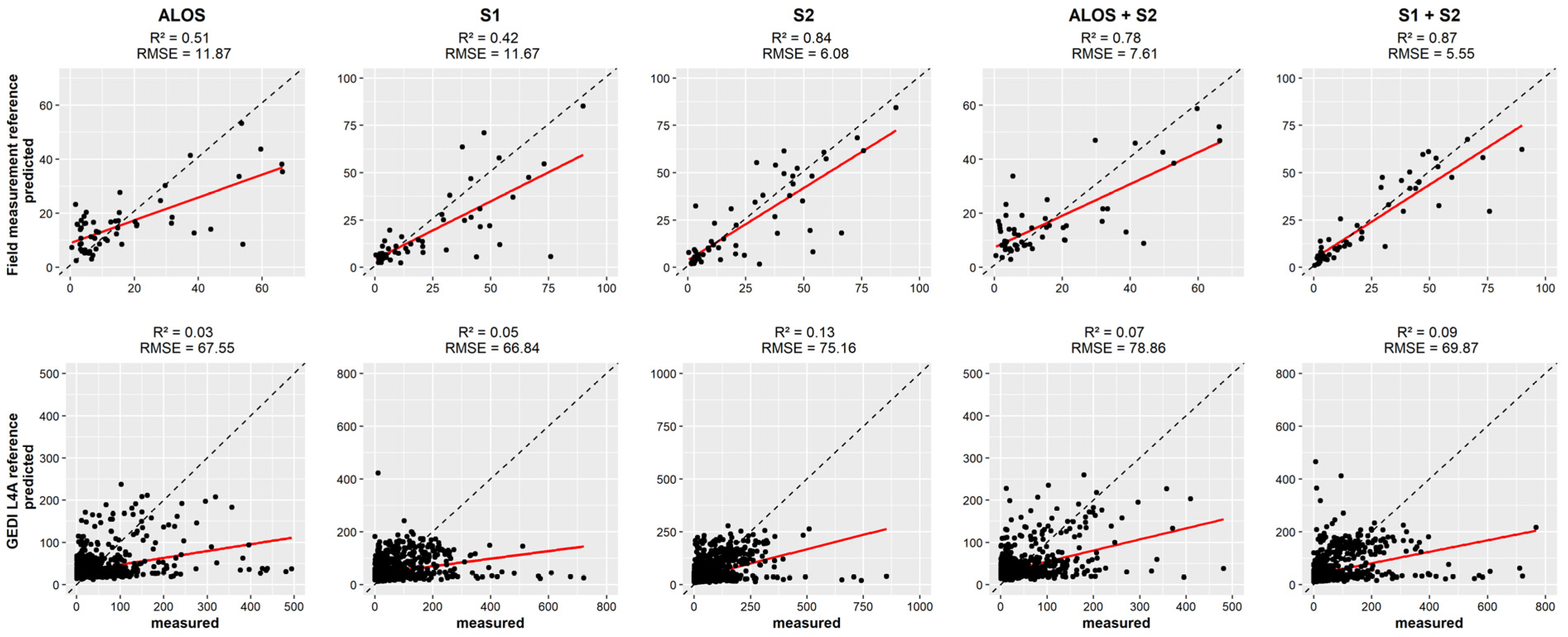

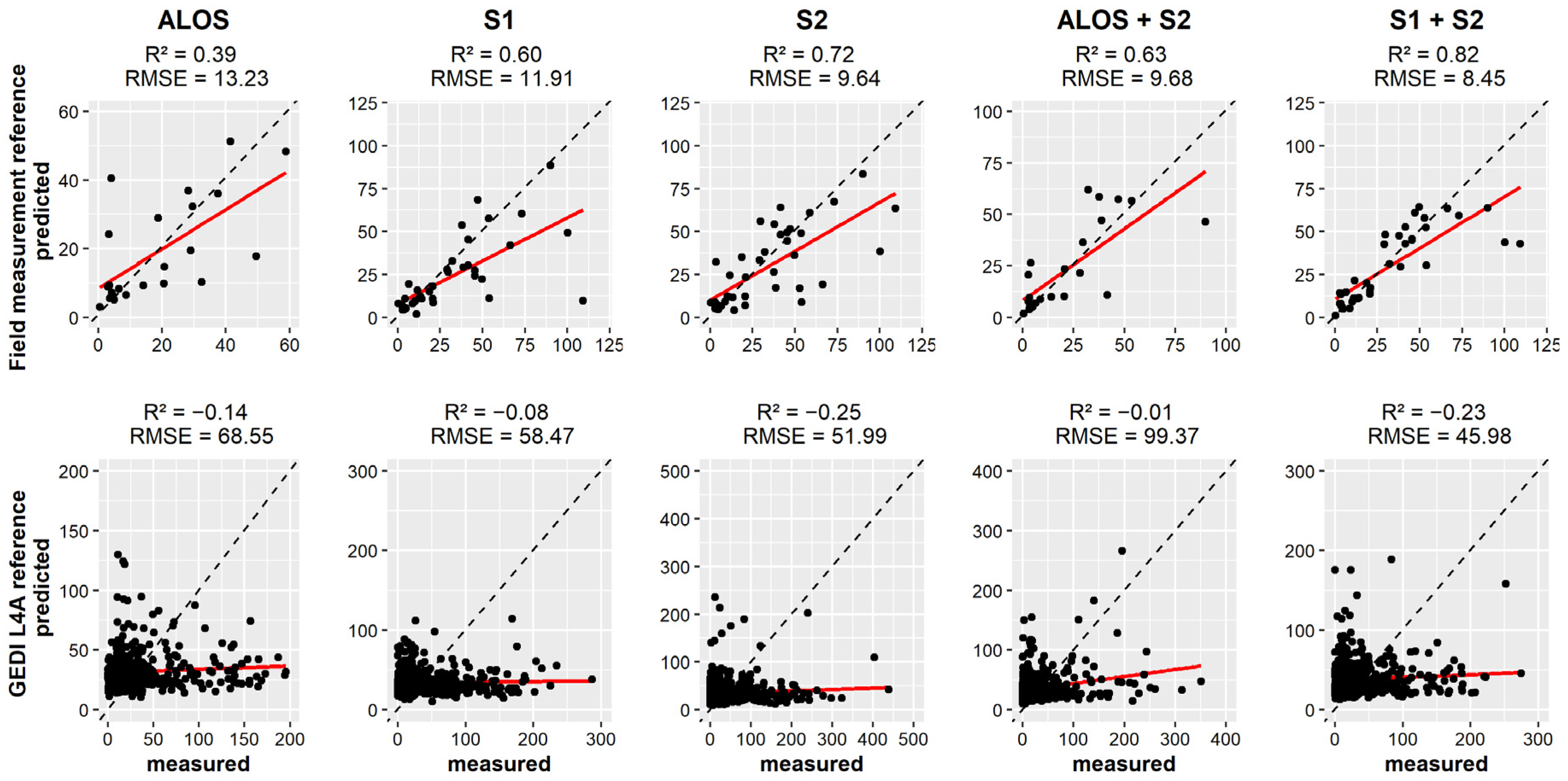

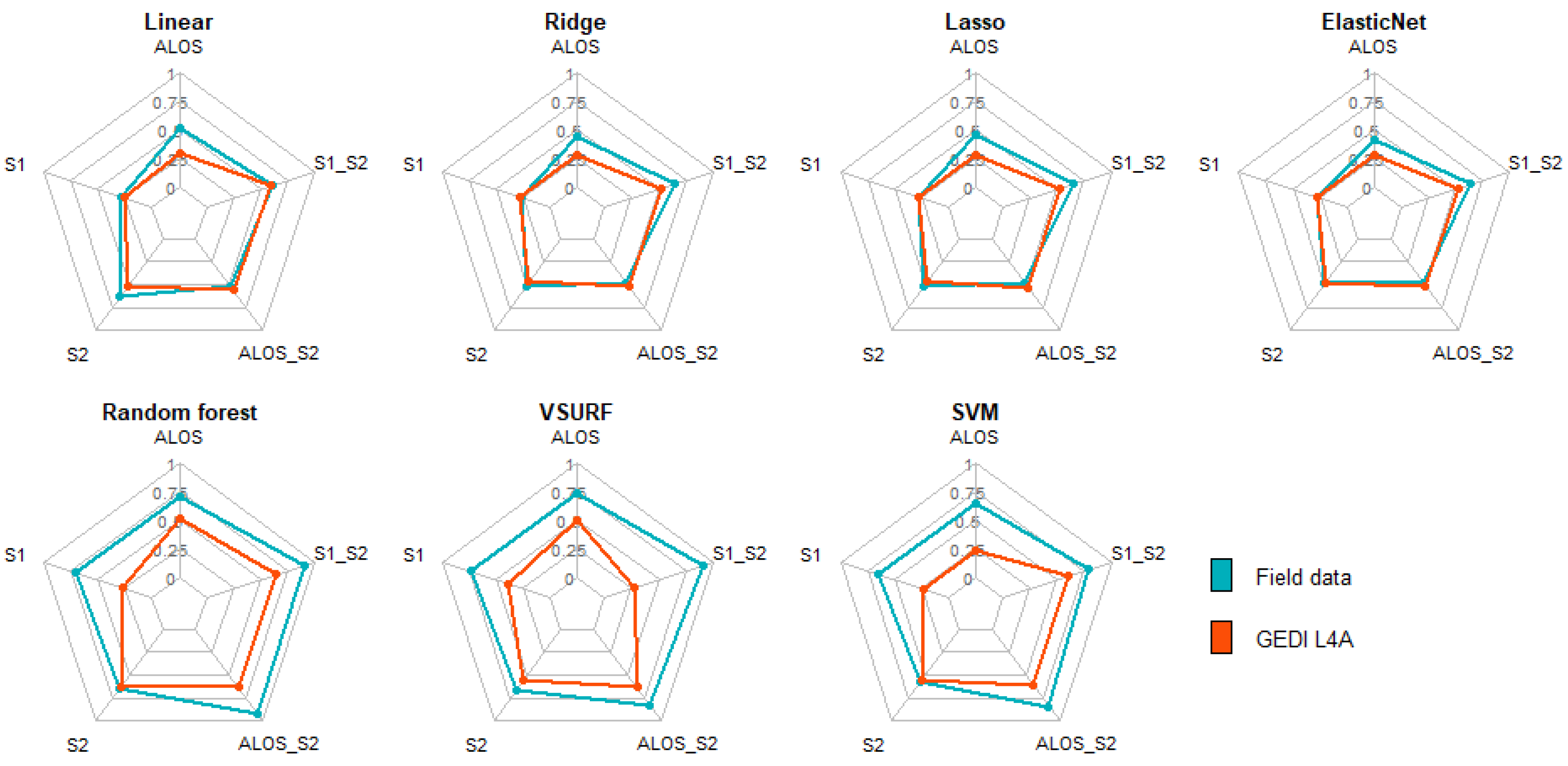
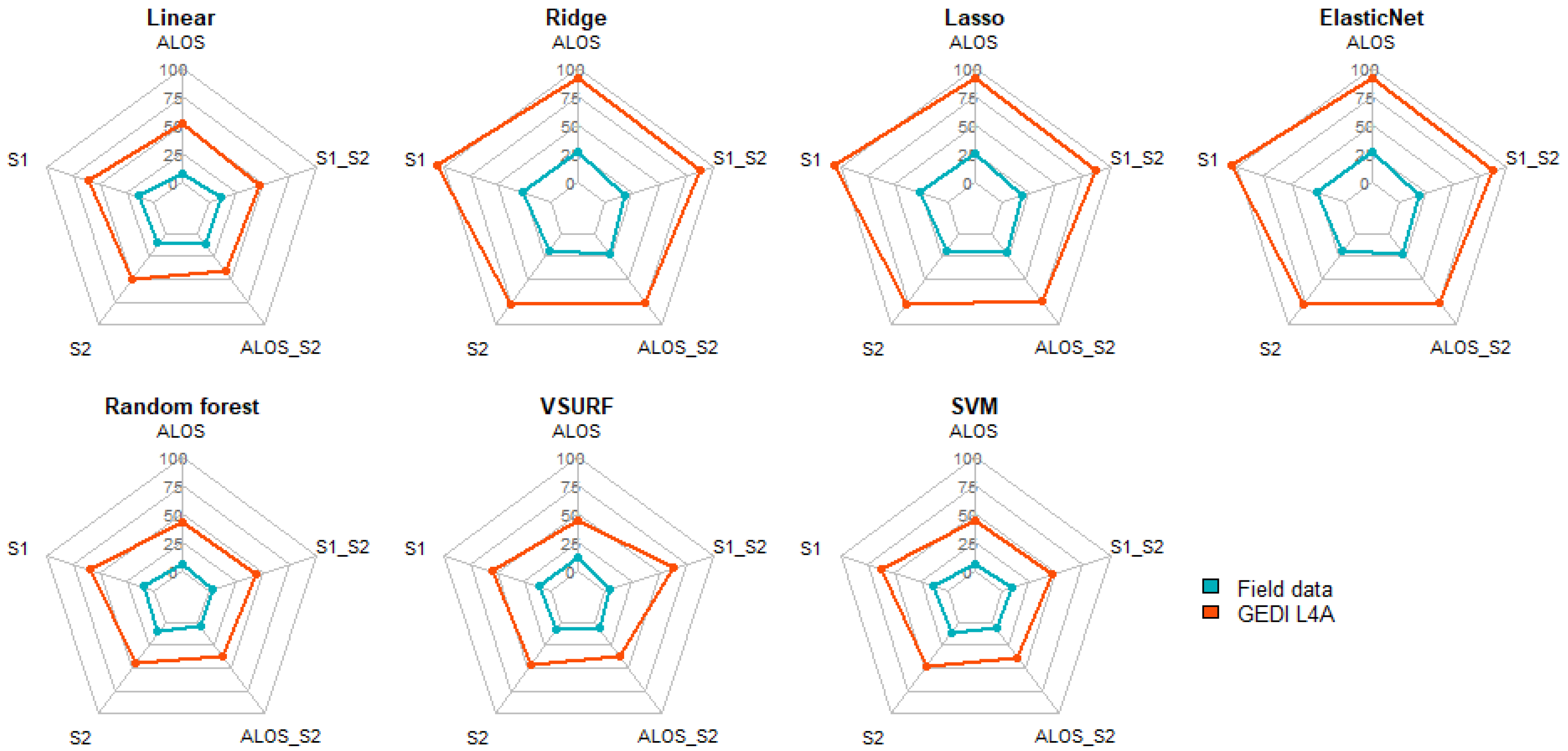
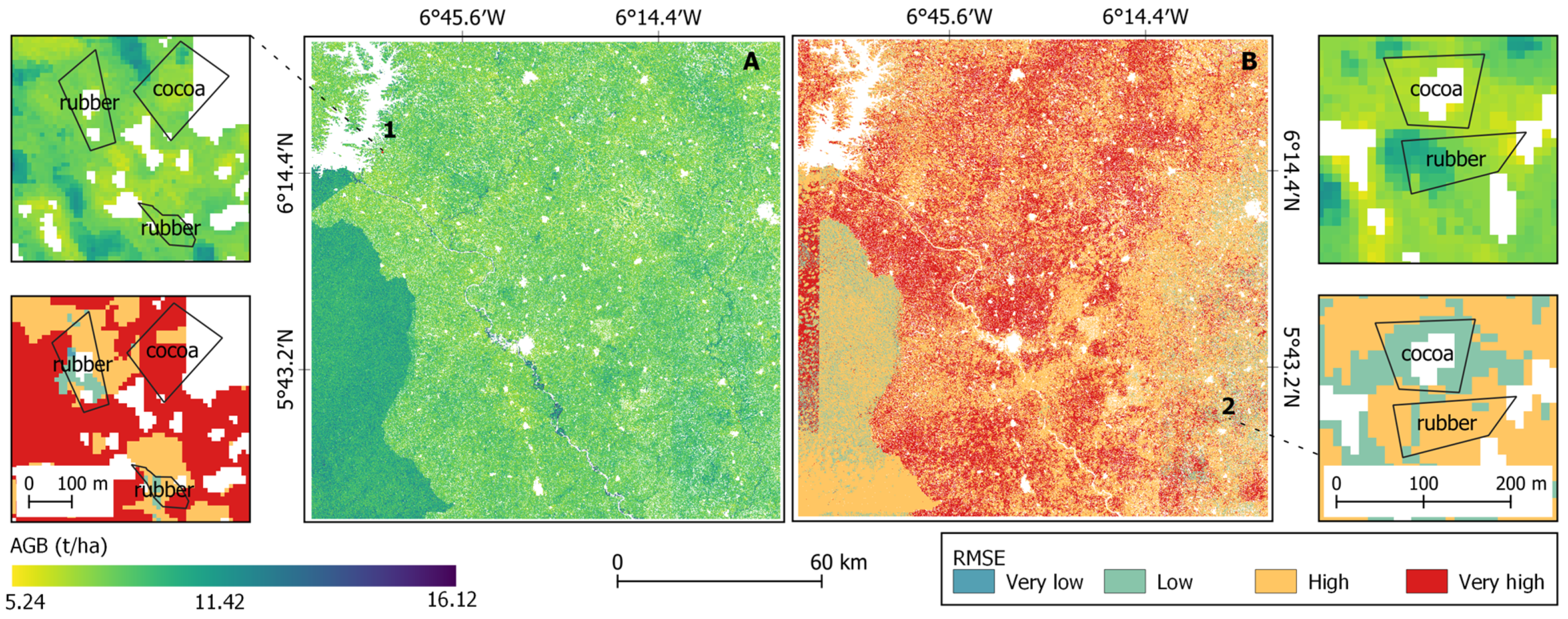



| AFS | Description |
|---|---|
| 1. Home gardens | Combination of trees and crops around farmer’s house. The woody components are often fruit trees. |
| 2. Improved fallow | Perennial planted or left to grow during fallow. The woody components are fast-growing leguminous tree species |
| 3. Multipurpose trees on croplands | Trees scattered in cropland. The perennial components are multipurpose trees (fruits, medicine, fodder, firewood, etc.) |
| 4. Plantation crop combinations | Mixture of trees and cash crop such as cocoa, rubber, mango, and cashew. The associated tree species are often forest tree species. |
| Vegetation Indices | Formula |
|---|---|
| 1. Normalized Difference Vegetation Index (NDVI) | (NIR − R)/(NIR + R) |
| 2. Green Leaf Index (GLI) | (2 × G − R − B)/(2 × G + R + B) |
| 3. Enhanced Vegetation Index (EVI) | 2.5 × (NIR − R)/(NIR + 6 × R − 7.5 × B + 1) |
| 4. Soil Adjusted Vegetation index (SAVI) | (1 + L) × (NIR − R)/(NIR + R + 0.5) |
| 5. Modified Soil Adjusted Vegetation Index (MSAVI) | 0.5 × (2 × NIR + 1 − sqrt ((2 × NIR + 1)2 − 8 × (NIR − R))) |
| 6. Transformed Chlorophyll Absorption in Reflectance Index (TCARI) | 3 × ((RE − R) − 0.2 × (RE − G) × (RE/R)) |
| 7. Visible Atmospherically Resistance Index (VARI) | (G − R)/(G + R − B) |
| Texture Measures | Formula | Explanation |
|---|---|---|
| Entropy | ∑ − ln(Pij) Pij | Smaller Pij leads to higher entropy value |
| Contrast | ∑Pij (i − j)2 | Express difference as an exponential function |
| Variance | ∑Pij (i − µi)2 | Describe the variance of GLCM values |
| Correlation | ∑Pij [(i − µi) (j − µi)/σ2] | Describe the correlation of GLCM values |
| Mean | ∑Pij/N | Describe the mean of the GLCM values |
| Homogeneity | ∑Pij/(1 + (i − j))2 | Express difference as an inversed exponential function |
| Dissymmetry | ∑(∑(|i − j| Pij)) | Express difference as a linear function |
| Second moment | ∑(∑(Pij)2) | Return the max value when all pixels are identical |
| Climatic Region | AFS | Carbon (Mg ha−1) | R2 | RMSE | N Plots |
|---|---|---|---|---|---|
| Guineo-Congolian | Farm | 6.97 ± 0.42 | 0.76 | 7.00 | 62 |
| Cocoa | 7.51 ± 0.6 | 0.6 | 7.48 | 30 | |
| Rubber | 7.33 ± 0.33 | 0.25 | 13.86 | 30 | |
| Guinean | Cashew | 13.78 ± 0.98 | 0.37 | 38.68 | 21 |
| Mango | 12.82 ± 0.65 | 0.58 | 21.07 | 22 | |
| Farm | 11.78 ± 0.19 | 0.78 | 6.62 | 23 | |
| Sudanian | Custard apple | 82.11 | 1 | ||
| Shea butter | 15.05 ± 7.34 | 11 | |||
| Apple-ring | 23.24 ± 10.3 | 5 | |||
| Marula | 6.59 ± 0.34 | 2 | |||
| African locust bean | 43.97 ± 54.38 | 6 |
Disclaimer/Publisher’s Note: The statements, opinions and data contained in all publications are solely those of the individual author(s) and contributor(s) and not of MDPI and/or the editor(s). MDPI and/or the editor(s) disclaim responsibility for any injury to people or property resulting from any ideas, methods, instructions or products referred to in the content. |
© 2022 by the authors. Licensee MDPI, Basel, Switzerland. This article is an open access article distributed under the terms and conditions of the Creative Commons Attribution (CC BY) license (https://creativecommons.org/licenses/by/4.0/).
Share and Cite
Kanmegne Tamga, D.; Latifi, H.; Ullmann, T.; Baumhauer, R.; Bayala, J.; Thiel, M. Estimation of Aboveground Biomass in Agroforestry Systems over Three Climatic Regions in West Africa Using Sentinel-1, Sentinel-2, ALOS, and GEDI Data. Sensors 2023, 23, 349. https://doi.org/10.3390/s23010349
Kanmegne Tamga D, Latifi H, Ullmann T, Baumhauer R, Bayala J, Thiel M. Estimation of Aboveground Biomass in Agroforestry Systems over Three Climatic Regions in West Africa Using Sentinel-1, Sentinel-2, ALOS, and GEDI Data. Sensors. 2023; 23(1):349. https://doi.org/10.3390/s23010349
Chicago/Turabian StyleKanmegne Tamga, Dan, Hooman Latifi, Tobias Ullmann, Roland Baumhauer, Jules Bayala, and Michael Thiel. 2023. "Estimation of Aboveground Biomass in Agroforestry Systems over Three Climatic Regions in West Africa Using Sentinel-1, Sentinel-2, ALOS, and GEDI Data" Sensors 23, no. 1: 349. https://doi.org/10.3390/s23010349
APA StyleKanmegne Tamga, D., Latifi, H., Ullmann, T., Baumhauer, R., Bayala, J., & Thiel, M. (2023). Estimation of Aboveground Biomass in Agroforestry Systems over Three Climatic Regions in West Africa Using Sentinel-1, Sentinel-2, ALOS, and GEDI Data. Sensors, 23(1), 349. https://doi.org/10.3390/s23010349









